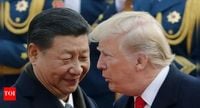On April 24, 2025, President Donald Trump asserted that trade talks with China are actively occurring, a claim that has been met with strong denial from Beijing. This latest development in the ongoing US-China trade war has sparked a flurry of reactions, with Chinese officials labeling Trump's statements as "fake news." In a statement, Guo, a spokesperson for the Chinese government, emphasized that no consultations or negotiations regarding tariffs have taken place between the two nations.
Trump's comments come on the heels of a significant day on Wall Street, where the Dow Jones Industrial Average surged by 486 points, the Nasdaq rose by nearly 458 points, and the S&P 500 climbed by almost 109 points. The market's optimism appears to stem from speculation that both countries might reduce tariffs in the future, despite Treasury Secretary Scott Bessent indicating on April 23 that in-depth trade discussions with China were being sidelined for the time being.
Bessent has described the current tariffs as "unsustainable" for American businesses, raising concerns about the potential for empty shelves in US stores due to a lack of Chinese goods. As it stands, the average US tariff rate on Chinese products is a staggering 147.6%, according to the Peterson Institute for International Economics, while China has retaliated with an average tariff of 124.1% on US imports.
During his presidency, Trump significantly increased tariffs, leaving office with an average rate of 19.3%, a dramatic rise from the 3.1% rate when he first took office in 2017. His successor, former President Joe Biden, maintained these tariffs and even introduced additional ones, including a 100% levy on electric vehicles and a 50% duty on solar panel components.
In a recent escalation of the trade war, Trump imposed an additional 20% tariff on Chinese exports of fentanyl, a substance linked to the deaths of an estimated 334,000 Americans over the last five years. Despite this, Trump has paused reciprocal tariffs for most countries until early July, with the hope of negotiating new deals that could reduce the US trade deficit and dismantle foreign tariffs and non-tariff barriers.
Meanwhile, the Chinese government has taken a firm stance against Trump's claims. On the same day as Trump's assertions, the Ministry of Commerce spokesman, He Yadong, reiterated that China is open to negotiations but insisted that any discussions must be based on mutual respect and equality. He stated, "Any claims about the progress of China-US trade negotiations are groundless as trying to catch the wind and have no factual basis."
In response to the ongoing trade tensions, social media in China has erupted with commentary, with phrases like "Trump chickened out" trending among users. Posts on Chinese platforms have mocked Trump's shifting positions, with comments such as "He's like a child who changes his stances instantly" and "Today's Trump beat yesterday's Trump, what will tomorrow's Trump do?"
The Wall Street Journal weighed in on the situation, suggesting that China has effectively called Trump's bluff in this round of the trade war. The editorial board noted that while Trump had initially imposed tariffs, President Xi Jinping's administration has responded with a more aggressive approach this time, utilizing various economic and diplomatic strategies against the US.
China's response to the trade war has included restricting exports of rare earth minerals and initiating multiple cases against the US at the World Trade Organization. These actions indicate a strategic maneuvering on China's part, as they seek to leverage their position in the global market.
As the trade war continues to evolve, the stakes remain high for both nations. The potential for a significant trade deal hangs in the balance, with both sides seemingly at an impasse. Bessent has expressed optimism about the possibility of reaching a major agreement, stating, "There is an opportunity for a big deal here" between the US and China.
As the situation develops, it is clear that the complexities of US-China relations will continue to shape the global economic landscape. The interplay of tariffs, negotiations, and international reactions will be closely monitored by businesses and governments alike, as they seek to navigate the uncertainties of this critical economic relationship.
In conclusion, the conflicting narratives surrounding US-China trade talks underscore the challenges both nations face in reaching a resolution. As both leaders seek to assert their positions, the path forward remains fraught with tension and uncertainty.




